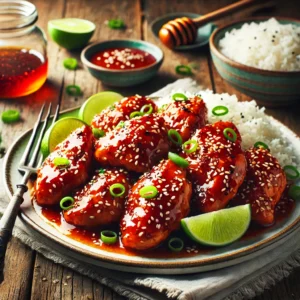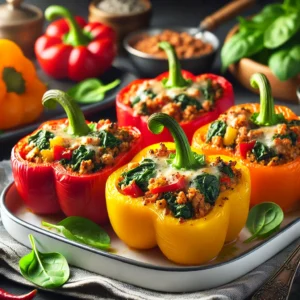
When it comes to barbecue, few dishes command as much respect as a smoked brisket.
Known for its tender, juicy texture and mouthwatering flavor, brisket is the star of any BBQ feast.
Whether you’re an experienced pitmaster or a weekend grilling enthusiast, nailing the perfect smoked brisket recipe can be a challenge, but with the right technique and a bit of patience, anyone can master it.
In this guide, we’ll walk you through the ultimate smoked brisket recipe, including the steps.
From choosing the right cut of meat to managing your smoker’s temperature, we’ve got you covered.
What Is Brisket?

Brisket is a cut of beef that comes from the chest or lower breast area of the cow.
It’s a tough, muscular cut that requires slow, low-temperature cooking to break down the connective tissue, making it tender and flavorful.
A good smoked brisket recipe will transform this tough cut into something so tender it practically melts in your mouth.
Brisket comes in two parts:
- The Flat (or First Cut): The leaner part of the brisket with a uniform thickness.
- The Point (or Second Cut): A fattier section that’s full of flavor and typically juicier.
When buying brisket, many BBQ enthusiasts prefer a whole packer brisket, which includes both the flat and the point. This allows for a more flavorful and juicy outcome.
Essential Ingredients for the Ultimate Smoked Brisket Recipe
Before you dive into the smoked brisket recipe, it’s essential to gather the right ingredients.
While smoking techniques and tools are critical, the quality of your ingredients also plays a huge role in the final outcome.
Brisket:
- A whole packer brisket (10-15 lbs is ideal for most backyard smokers)
- Make sure the brisket has a nice fat cap and is evenly marbled.
Rub:
- Salt: Enhances the natural beef flavor.
- Black Pepper: Adds a subtle spice and enhances the smoke flavor.
- Paprika: Provides a touch of sweetness and color.
- Garlic Powder & Onion Powder: Adds depth to the rub.
- Brown Sugar (optional): For a touch of sweetness and caramelization.
Binder:
- Yellow mustard or olive oil to help the rub adhere to the brisket.
Wood for Smoking:
- Oak, hickory, or mesquite are popular choices for smoking brisket.
Preparing the Brisket
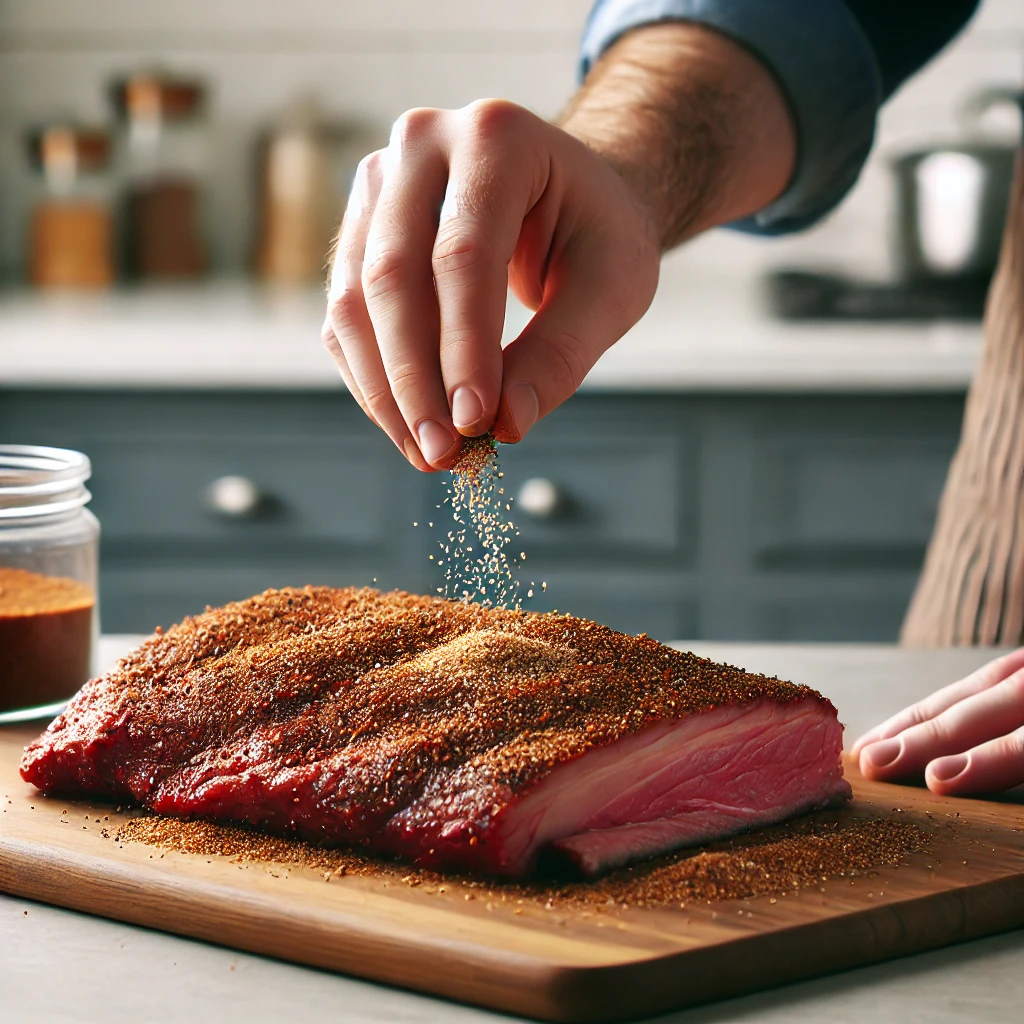
The key to a successful smoked brisket recipe starts with proper preparation. This involves trimming the brisket, applying the rub, and letting the meat rest before it hits the smoker.
Step 1: Trim the Brisket
Trimming your brisket properly is essential for even cooking. Here’s how to do it:
- Trim excess fat: Start by trimming down the fat cap to about 1/4-inch thick. You want some fat for flavor, but too much can prevent the rub from penetrating the meat.
- Remove silver skin: This is the thin, tough membrane on the underside of the brisket. Removing it helps the seasoning penetrate the meat and improves texture.
- Shape the brisket: Make sure the edges are uniform to help the brisket cook evenly.
Step 2: Apply the Rub
Once your brisket is trimmed, it’s time to apply the rub.
- Apply a binder: Coat the brisket lightly with yellow mustard or olive oil. This doesn’t add much flavor but helps the rub adhere.
- Generously apply the rub: Sprinkle your seasoning mixture generously over the entire brisket, ensuring even coverage on all sides. Let the brisket sit at room temperature for about 30 minutes to absorb the flavors.
Step 3: Let the Brisket Rest
After applying the rub, let the brisket rest. This allows the flavors to settle into the meat. You can either leave it at room temperature for about an hour or refrigerate it overnight if you’re prepping ahead.
Smoking the Brisket

Now that your brisket is prepped, it’s time for the star of the show—the smoking process.
A successful smoked brisket recipe requires attention to detail, particularly when it comes to managing temperature and smoke.
Step 1: Prepare the Smoker
- Preheat your smoker: 225°F to 250°F. This low and slow method allows the tough brisket to become tender over time.
- Add wood: Use hardwoods like oak, hickory, or mesquite for a bold, smoky flavor. Add your wood chunks or chips to the smoker once it reaches the desired temperature.
Step 2: Place the Brisket on the Smoker
- Fat side up or down? This is a hotly debated topic. Some prefer fat side up to allow the fat to baste the meat as it cooks. Others prefer fat side down to protect the meat from direct heat. Try both and see which works best for your smoker.
- Positioning the brisket: Place the brisket on the smoker with the thicker end facing the heat source, as it will take longer to cook.
Step 3: The Smoking Process
- The Stall: After a few hours, your brisket’s internal temperature will hit around 160°F to 170°F and will stop rising for a while—this is known as “the stall.” It can last for hours, but don’t worry—this is perfectly normal.
- Wrap the brisket: To push through the stall, many pitmasters wrap their brisket in butcher paper.
- This locks in moisture and helps speed up the cooking process.
Step 4: Monitor Temperature
- Internal temperature: Brisket is done when it reaches an internal temperature of about 200°F to 205°F.
- Use a meat thermometer to check.
- The feel test: Brisket is ready when it feels like butter when probed with a meat thermometer or a skewer.
Resting and Slicing the Brisket
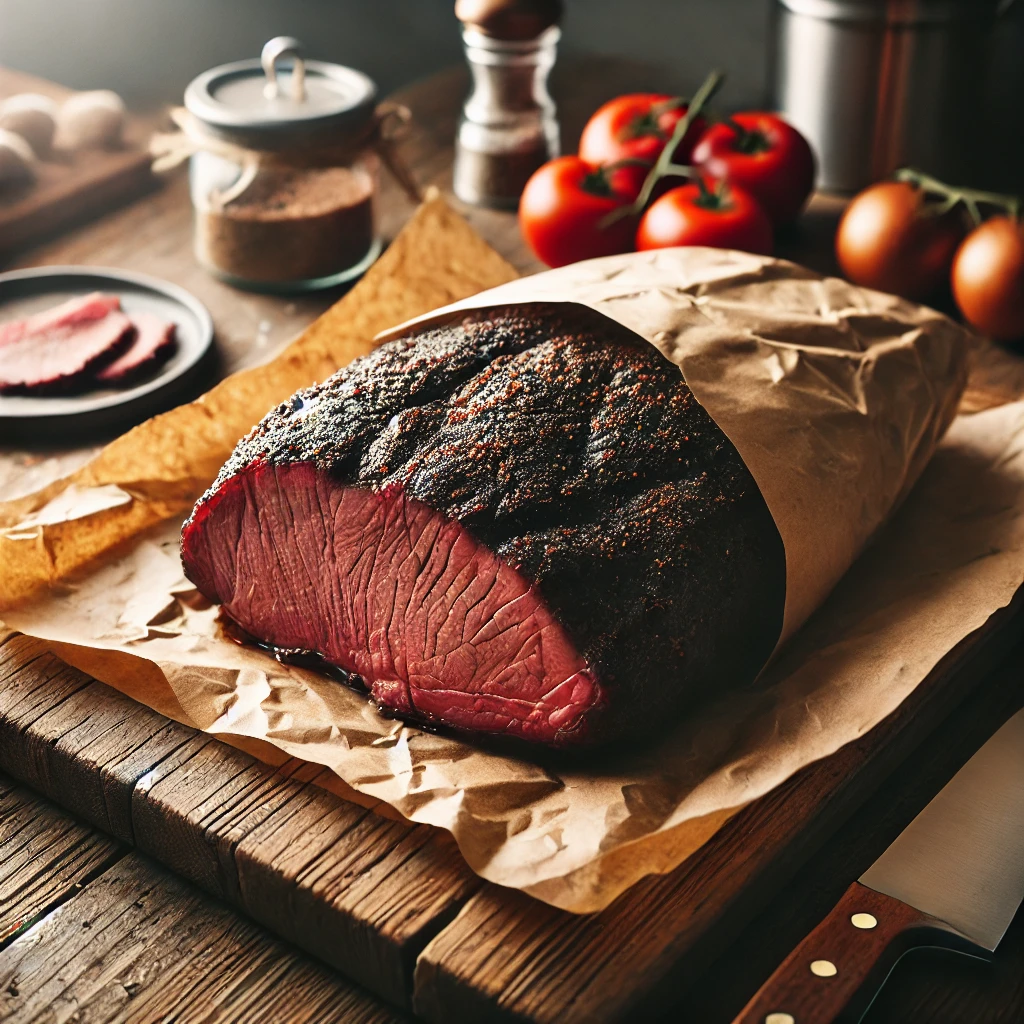
After all the hard work of smoking, the next step in your smoked brisket recipe is just as important—resting and slicing.
Step 1: Let It Rest
- Resting is crucial: Once the brisket reaches the desired temperature, remove it from the smoker and let it rest for at least 1 hour, wrapped in foil or butcher paper and placed in a cooler or on the counter. This allows the juices to redistribute throughout the meat, making the brisket moist and tender.
Step 2: Slicing the Brisket
- Slice against the grain: When you’re ready to serve, it’s important to slice the brisket against the grain to ensure tenderness. The grain in the flat and the point run in different directions, so make sure to adjust your slicing method depending on which part you’re cutting.
Serving Suggestions for Smoked Brisket

A smoked brisket recipe wouldn’t be complete without considering the best ways to serve your masterpiece. Here are some popular serving ideas to pair with your perfectly smoked brisket:
- Classic BBQ sides: Serve with coleslaw, baked beans, potato salad, or mac and cheese for a traditional BBQ feast.
- Brisket sandwiches: Pile slices of brisket on a soft roll, topped with BBQ sauce and pickles.
- Brisket tacos: Slice the brisket thin and serve in warm tortillas with avocado, salsa, and cilantro for a Tex-Mex twist.
- Brisket nachos: Top tortilla chips with shredded brisket, cheese, and jalapeños for a loaded appetizer.
Common Mistakes to Avoid

Even with the best smoked brisket recipe, there are a few common mistakes that can derail your BBQ.
Here’s how to avoid them:
1. Not Trimming Enough Fat
Leaving too much fat on the brisket can prevent the rub from penetrating the meat and result in uneven cooking.
2. Opening the Smoker Too Often
Every time you open the smoker, you lose heat and smoke, which can prolong the cooking process.
Try to resist the urge to check the brisket too frequently.
3. Undercooking or Overcooking
Make sure to monitor the internal temperature carefully.
Brisket that hasn’t cooked long enough will be tough, while overcooked brisket will be dry.
4. Skipping the Rest Period
Resting the brisket after cooking is crucial for retaining moisture.
Skipping this step can result in dry, tough brisket.
Why Snake River Farms American Wagyu Beef is the Best Choice for Brisket

When it comes to choosing the right cut of meat for your smoked brisket recipe, the quality of the beef can make all the difference.
If you’re looking to elevate your BBQ game and achieve the most tender, flavorful brisket possible, Snake River Farms American Wagyu beef is an excellent option.
Known for its superior marbling, rich flavor, and unmatched tenderness, this high-quality beef can take your brisket to the next level.
What Makes Snake River Farms American Wagyu Special?
Snake River Farms is renowned for producing some of the finest American Wagyu beef, a hybrid of traditional Japanese Wagyu cattle and premium American breeds.
This blend creates the perfect balance of marbling and beefy flavor, making it ideal for low and slow smoking.
- Marbling: One of the standout features of American Wagyu brisket is the incredible marbling throughout the meat.
- Marbling refers to the thin streaks of fat that run through the muscle, which melt during the smoking process and result in a juicier, more flavorful brisket.
- This higher fat content makes American Wagyu particularly well-suited for long smoking sessions, ensuring the meat stays tender and moist.
- Rich Flavor: Thanks to the unique genetics of Wagyu cattle, American Wagyu has a deeper, richer flavor than regular brisket.
- This means you don’t need to rely as heavily on rubs and sauces to enhance the taste—the meat speaks for itself.
- Snake River Farms American Wagyu brisket offers a buttery texture and savory flavor that is hard to beat.
- Tenderness: The tenderness of American Wagyu brisket is unparalleled.
- Even after hours in the smoker, this cut of meat remains incredibly soft and easy to slice.
- Whether you’re a seasoned pitmaster or just starting, using American Wagyu can make achieving a tender, melt-in-your-mouth brisket much easier.
Why Snake River Farms?
Snake River Farms is a trusted source for high-quality American Wagyu beef.
Their commitment to raising cattle in an ethical and sustainable manner results in superior meat that stands out in both flavor and texture.
Here’s why Snake River Farms is a top choice for sourcing your brisket:
- Sustainability: Snake River Farms prioritizes sustainable farming practices, ensuring that their cattle are raised in a way that’s good for the environment and for the animals.
- This means you can enjoy your brisket knowing that it comes from a responsible source.
- Consistent Quality: Every cut of beef from Snake River Farms is hand-selected for quality, ensuring you get a premium product every time.
- Whether you’re cooking for a family BBQ or a special occasion, their American Wagyu brisket guarantees a memorable dining experience.
- Delivery to Your Door: Snake River Farms offers convenient online ordering with delivery straight to your door.
- This makes sourcing a high-quality brisket for your smoked brisket recipe easier than ever, especially if premium cuts aren’t available locally.
How to Smoke Snake River Farms Wagyu Brisket
When preparing a Snake River Farms American Wagyu brisket, the process is similar to smoking regular brisket, but there are a few things to keep in mind to get the best results:
- Less Rub, More Beef Flavor: Since American Wagyu brisket is already rich and flavorful, you don’t need to go heavy on the rub.
- A simple salt and pepper rub, or a light layer of garlic and onion powder, will enhance the beef’s natural taste without overpowering it.
- Longer Resting Period: Due to the higher fat content, you may want to rest your Wagyu brisket for a bit longer than you would with a regular brisket.
- This allows the juices to redistribute throughout the meat, resulting in a more flavorful and tender final product.
- Watch the Temperature: Wagyu brisket tends to cook faster than traditional beef due to the extra marbling.
- Be sure to monitor the internal temperature closely to avoid overcooking.
- The ideal internal temperature for Wagyu brisket is still around 200°F to 205°F, but the meat will likely reach this faster than a leaner cut.
A Worthwhile Investment for BBQ Lovers
While Snake River Farms American Wagyu brisket is a premium product and costs more than standard brisket cuts, it’s a worthwhile investment for any BBQ enthusiast who wants to experience the pinnacle of smoked brisket.
Whether you’re hosting a backyard BBQ or competing in a barbecue competition, using American Wagyu brisket will set your meal apart and impress even the most discerning guests.
Incorporating Snake River Farms American Wagyu beef into your smoked brisket recipe is the ultimate way to ensure your brisket is tender, juicy, and packed with flavor.
For the ultimate brisket experience, consider investing in this top-tier beef for your next BBQ session.
Conclusion: Perfecting Your Smoked Brisket Recipe
Smoking brisket is an art that takes time and practice to master, but with the right smoked brisket recipe, you can achieve tender, flavorful results every time.
Remember, success is in the details—from trimming and seasoning to monitoring the smoker’s temperature and resting the meat.
With patience and the tips shared in this guide, you’ll soon be serving up perfectly smoked brisket that impresses family and friends at your next BBQ gathering. Happy smoking!
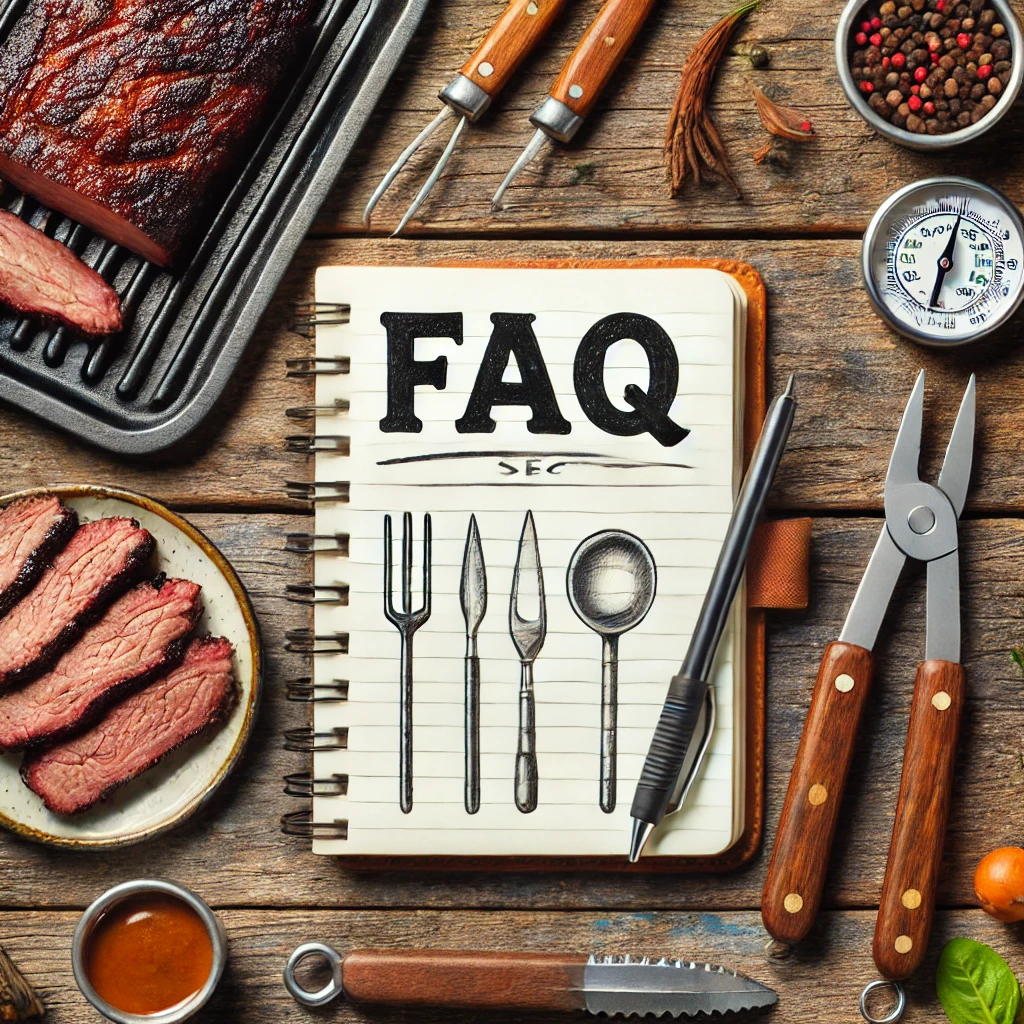
Related Articles:
Why Snake River Farms is the Gold Standard in American Wagyu Beef
Hearty and Homestyle: Must-Try Dutch Oven Recipes for Family Dinners

